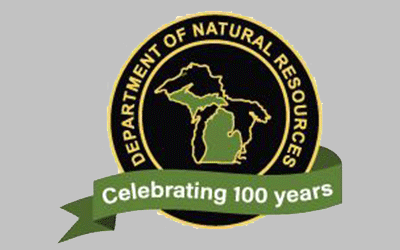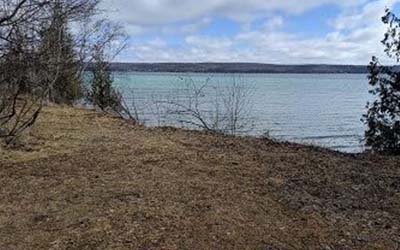A visit to a reflecting pond
“Well I was born in a small town, and I can breathe in a small town. Gonna die in this small town and that’s probably where they’ll bury me,” – John Mellencamp
By JOHN PEPIN
Michigan Department of Natural Resources
Just inside the Ontonagon County side of the Ontonagon-Houghton county line, situated along Mill Pond Road, is a small dam across Trout Creek — a picturesque place to be.
The scene is pastoral, with small homes scattered sporadically about a lush and green countryside, split by a two-lane state highway.
This area was once home to white oak lumbering. The lumber town hummed during the 1920s, with passenger rail trains stopping along this stretch of the former Duluth, South Shore and Atlantic Railway.
There’s a fish ladder here connecting the stilled waters of the pond pooled behind the dam with the swirling waters racing downstream. The railroad named a station for Trout Creek in the late 1800s, which the community later adopted.
Fish can jump the ascending steps in the ladder, one at a time, climbing to reach the pond; or they can freely move downstream from the impoundment, over each rung in the ladder, to a small plunge pool at the foot of the structure.
This quiet place attracts visitors looking for a place to find a few peaceful moments, casting their thoughts into the placid waters of the reflective pool, and maybe a line or two for trout.
There’s a blue, metal bench here at the top of the dam, perfect for sitting comfortably.
From this seat, you can watch the sun set down below the high-line wire and the trees on the western horizon, where the Duluth South Shore and Atlantic — later to become the Soo Line — used to run.
Waters on the pond are rippled tonight by a lone Canada goose, slowly gliding around like a tall sailing ship guarding the entrance to a harbor.
Dark, bent and blurred shadows of the trees, the utility poles along the highway and a few signs in the distance also appear in reflection on the water.
As the sky darkens, infrequent headlights on the highway approach, heading east, the sound of wheels on the blacktop can be heard rumbling from a good distance away.
Meanwhile, the colors in the sky — orange, yellow, pink, blue, purple and red — slowly blend and burn down into the embers and ashes of another day.
A long time ago, the railroad station picked up and dropped off passengers four times each day. Today, the passenger trains have disappeared. Less than 400 people live in this township now, much of which is located within the Ottawa National Forest.
A kid named Richard Henry Pole was born here, a right-hander who went on to pitch in Major League Baseball — talk about a small-town boy’s dream come true! Not just the majors, but the 1975 World Series, no less.
Earlier that year, Pole caught a line drive in the face that shattered his jaw and damaged his retina, but he still pitched for the Red Sox in the series.
In this remote lumbering community, that’s a tale as big as Paul Bunyan or Babe the Blue Ox. Nearly half a century later, it’s still remembered.
But there are other heroes who came from this small unincorporated community too.
These heroes got to pitch in bigger battles — World War II, Korea and Vietnam and the like. Towns little and big, scattered across the vastness of America, are home to war heroes like these.
Some still live in this town, others are buried here. Still others remain missing or lie under the earth in foreign lands — they died there, never making it back home.
After the close of the Civil War, Decoration Day was created. Graves were decorated with flowers, honoring the dead from the country’s horrific war that claimed more than 600,000 lives.
The first commemoration was held in 1868 at Arlington National Cemetery in Virginia with 20,000 graves decorated.
The Civil War’s northern states had all recognized the observance by 1890, but some southern states refused to participate, instead preferring a separate date to honor Confederate war dead.
After World War I, the focus of Decoration Day was changed to honor the dead from all wars. Some states still observe a Confederate Memorial Day in April. It’s called “State Holiday” in Georgia.
Since 1971, Memorial Day has been a federal holiday — celebrated on the last Monday of May — marked by solemn ceremonies at cemeteries, the continued decoration of graves and the sale of poppies to wear as additional acknowledgement of the sacrifices made by those who wore a military uniform and paid for America’s freedom with their lives.
At the pond on Trout Creek, the blue metal bench has a plaque attached honoring some of these local war heroes, men who at one point had no doubt watched the magnificent sunsets here, cast their thoughts into the reflective pool and watched the cars pass by on the two-lane blacktop.
The plaque reads: “In memory of these men killed in action while serving our country in WWII, Korea, Vietnam: Joe Cameron, Jerry Garrick, Tom Heikkala, Marvin Helsius, Jack Porter, Walt Pulkas, Ed Trombley; each loved to fish here.”
On another day, a sunny day, two young boys get off their bikes at the dam and take a seat on the bench. While they work wriggling worms onto their fishhooks, a swallow glides and bends over the waters of the pond, twisting like a fighter jet, higher into the clear blue skies.
Indeed, the little pond at the dam over Trout Creek is one place of thousands sprinkled like seeds across our nation. A place for reflection, a place for remembering.
Check out previous Showcasing the DNR stories in our archive at Michigan.gov/DNRStories. To subscribe to upcoming Showcasing articles, sign up for free email delivery at Michigan.gov/DNR.
/Note to editors: Contact: John Pepin, Showcasing the DNR series editor, 906-226-1352. An accompanying photo and a text-only version of this story are available below for download. Caption information follows. Credit Michigan Department of Natural Resources, unless otherwise noted.
Text-only Showcasing Column
Sunset: A beautiful sunset over the western Upper Peninsula is shown./ |









